On Conference Realignment and the Consolidation of Power
Posted by rtmsf on April 27th, 2010Andrew Murawa is the RTC correspondent for the Pac-10 and Mountain West Conferences and an occasional contributor.
Overview
College sports fans dodged a major bullet last week when the NCAA announced that the men’s basketball tournament would only be expanding to 68 entrants, rather than the 96-team field that had been widely rumored. However, the face of college sports as we know it is still in jeopardy, as the specter of widespread conference realignment still looms, with the much-speculated-upon expansion of the Big Ten as the key domino that could start a wave of changes leaving the college sports landscape drastically altered.
The elephant in the room issue is the consolidation of power away from the existing six BCS conferences and into a smaller number of “superconferences” with the possibility looming that once any realignment sorts itself out and we’ve got four 16-team conferences, those conferences break away from the NCAA and form their own structure. As Kansas athletic director Lew Perkins puts it: “At some time, the major conferences are going to have their own quasi-NCAA. They’re going to do their own thing.” Former Syracuse AD Jake Crouthamel was even more specific, saying that eventually the Big Ten, ACC, SEC and Pac-10 would expand and ultimately leave the NCAA, even to the point of forming their own competing basketball tournament: “If you look at the history of what’s been going on for the last decade, I think it’s leading in that direction.”
The potential expansion of conferences detailed below is not the first shot fired in the consolidation of power, but the next step in an already-existing series of moves that has widened the financial gap between the biggest athletic departments and the rest of the supporting cast. And, as those at the top get bigger and bigger, the underdogs not only fall behind in terms of funding, but they may ultimately be left completely behind: no more Boise State and Utah to steal BCS bowl spots from big-money institutions during the winter, and no more Butler and George Mason sneaking into the Final Four in the spring. While that type of doomsday scenario is still several decision points down the line, what happens in the Big Ten over the next twelve months or so could be the monumental tipping point to drastically move things in that direction.
At present, the most widely rumored targets for Big Ten expansion are Pittsburgh, Rutgers and Syracuse from the Big East and Nebraska and Missouri from the Big 12, although as always occurs when the Big Ten thinks about expansion, Notre Dame is in the mix and likely their number one choice. With the Pac-10 also in the midst of contemplating expansion within the next year, these moves could send a ripple effect throughout all of the Division I conferences causing some conferences to get bigger, others to contract, and even some to disappear. While the specifics remain conjecture and speculation at this point, there are enough common-sense scenarios out there to fuel theories to create one of the most helter-skelter flowcharts ever seen. We’ll take a look conference-by-conference at what could happen, and what kind of fallout might be created by each move, starting with our eleven midwestern friends.
Big Ten
Big Ten commissioner Jim Delany confirmed last Wednesday that his conference is considering not only expanding to 12, but also perhaps even 14 or 16 teams. While some of the rationale for the expansion would be the addition of a football championship game for more revenue, the accumulation of more content and more markets for the Big Ten Network is probably more important to their plans. Delany noted that while discussions for this expansion are ongoing, the 12-18 month timetable that was originally announced in December is still the current framework.
Starting with the first domino, there is little doubt that the Fighting Irish would be the Big Ten’s first choice and the most logical fit for the conference, in terms of geography, academics and, frankly, football. Notre Dame and the Big Ten have flirted with each other many times in the past, but there is likely a greater chance that they will consummate their relationship this time around than any time before. For the Big Ten, the attraction is obvious: a huge fan base in historic “Big Ten country,” a ton of athletic history, and excellent academics. For Notre Dame, however, the question is a lot tougher. The Irish have been a football independent throughout their history and current athletic director Jack Swarbrick recently said that their “highest priority is maintaining football independence.” Notre Dame is currently in the middle of a television contract with NBC for the rights to broadcast home football games, a contract that runs through 2015 and an issue that will need to be confronted somehow if the Irish are eventually invited and accept Big Ten membership. The amount of the NBC deal (about $15 million annually) is not prohibitive enough to prevent them from considering membership in the Big Ten, whose member schools currently receive about $20 million annually from their television contracts. It is even possible that if the Big Ten and Notre Dame can come to an agreement, all this expansion talk will end right there: Notre Dame joins up, the Big Ten stops at 12 teams, the Big East poaches a team from CUSA like Central Florida as an additional football school and geographic partner to South Florida or a basketball-only school from the A-10 like Rhode Island or Massachusetts and the end-of-the-world scenario is averted. At present, however, it is being reported that Notre Dame is not being considered in the Big Ten’s expansion plans (a report that nobody in their right mind believes), but if Notre Dame is interested, the Big Ten will certainly be interested as well.
However, it is also realistic that with or without Notre Dame, the Big Ten is aiming for 14 or 16 teams to become the first superconference. While the addition of teams such as Missouri and Nebraska makes the most geographic sense, this expansion thing is not really about logic but about dollars, and Delany seems most interested in all the potential viewers that the bigger east coast markets present — notably Rutgers and Syracuse, but also Pittsburgh and potentially Connecticut. Adding three or even all four of those schools would effectively kill Big East football as we know it and potentially damage the Big East basketball enough to persuade a fence-sitting Notre Dame to leap off onto the Big Ten side as well. Swarbick himself admitted in March that “there are things that are large enough to challenge our ability to remain independent and remain in the Big East.” All four (or even three) of those flagship Big East programs bolting for the Big Ten could be one of those “large enough” things.
There have also been rumors about the Big Ten talking to Texas, one of the wackier possibilities and a move that would go a long way toward shattering the Big 12, especially in combination with Nebraska bolting as well and other conferences cannibalizing the remaining Big 12 membership. Why would Texas want to leave their traditional rivals (notably, Oklahoma and Texas A&M) in the Big 12? Big old reason number one: money – the conference’s television contract pales in comparison to the Big Ten’s (or even the SEC’s, another interloper interested in stealing Texas away). While Texas joining the Big Ten is a longshot, it is still a possibility if the Big 12’s member institutions start to get spooked and scatter, something that might happen if Missouri and Nebraska commit early.
Big East
If the Big Ten and Notre Dame finally get hitched and everybody else is happy enough with that arrangement to stay put, the Big East could find one basketball-only replacement pretty easily without starting a resulting avalanche. They could even find an all-sports participant (UCF as mentioned above, or perhaps some other CUSA school) without afflicting too much damage. Although if they were to snap up Memphis, CUSA’s basketball legitimacy would fall off in a big way.
The doomsday scenario for the Big East occurs, however, if some combination of Syracuse, Pitt, Rutgers and Connecticut leave, swiftly eviscerating the conference’s football core and leaving Louisville, Cincinnati, West Virginia and South Florida looking for a home. Possible scenarios there include the Big East raiding Conference USA for teams like Memphis, UCF and/or Marshall, picking up some of the MAC outliers (Temple, Buffalo) or the whole pack leaving together to form a new conference, leaving basketball-only schools DePaul, Georgetown, Marquette, Providence, Seton Hall, St. John’s and Villanova to form a Catholic hoops league or possibly looking to the Atlantic 10 for reinforcements (Temple again, Rhode Island, UMass, Xavier, Richmond, Charlotte, Dayton, St. Joe’s).
The possibilities here are endless, but without a doubt rookie commissioner John Marinatto has his work cut out for him. He has already hired former NFL commissioner Paul Tagliabue as a consultant, and it is possible that the Big East, already at sixteen basketball schools, could look to expand proactively. There is early talk about trying to get Boston College back from the ACC and possibly swiping Maryland as well. Marinatto has begun talk about a Big East Network, and there are even a couple of ideas to handle the Notre Dame problem: for example, getting the Irish to agree to a deal where they are not a full football member but still schedule a certain number of Big East schools in exchange for their continued membership in the conference in basketball and the non-revenue sports.
From a basketball perspective, imagining a landscape where Georgetown and Syracuse (just to pick one historic rivalry) are not both members of the Big East is a bit scary. But if the nuclear option goes down and the Big East loses three schools to the Big Ten, they could still form a pretty impressive basketball-only conference by raiding the Atlantic 10. DePaul, Georgetown, Marquette, Providence, Seton Hall, St. John’s and Villanova plus Xavier, Temple, Rhode Island, Dayton and St. Joseph’s for a 12-team league? Yes, that could work, although it would leave the Atlantic 10 either dead or looking to poach teams from further on down the ladder.
Pac-10
Before we jump to some other conferences that would be impacted by the Big Ten expansion, let’s go west for a bit to another conference actively exploring expansion. Where the Big Ten is looking at options beyond merely a 12-team league, it is thought that 12 is the upper end of the spectrum for the Pac-10 for now. Twelve teams would give the conference the chance to hold a football championship game, but another scenario new Pac-10 commissioner Larry Scott is exploring is legislation that would allow a conference to hold a football championship game with only ten members. Throw into the mix the fact that the conference is looking for a new TV deal to replace their current one that expires at the end of 2012 and change is also afoot out west. One major hurdle for the conference to clear in order to be able to expand: expansion requires unanimous approval of the member institutions and there are rumors that Stanford president John Hennessy is against any expansion plans whatsoever.
If the Pac-10 does expand, they’ll be looking for a couple of teams in the same region to match their current ‘traveling partner’ setup. Colorado and Utah are probably the schools that the Pac-10 is most interested in. Both are large research institutions in sizable media markets and close enough together to be traveling partners. BYU and Missouri are far longer shots, with several other west coast athletic powerhouses (UNLV, San Diego State, Boise State, etc) likely having very little chance of being invited to join due to their lack of academic cohesion with the rest of the conference. The problem, however, is that while Utah would probably jump at the chance to bump up to the Pac-10, Colorado presently doesn’t have any reason to want to leave the Big 12. But, if CU administrators see storm clouds on the horizon for the Big 12, they may jump ship ahead of the sturm and drang. And, if Colorado goes west, along with Nebraska and Missouri heading to the Big Ten, maybe Kansas is suddenly also interested in Pac-10 membership. As the Big 12 then crumbles around it, Texas and Oklahoma will need a home, and what about the rest of the conference: Oklahoma State, Kansas State, Texas Tech, Baylor, Texas A&M, Iowa State. If the Big Ten goes to 16 teams and one other conference follows, a third of the BCS conferences is going to have to get swallowed up entirely, and with the Big 12 geographically in the middle of all the others, it is easy to see a scenario where it gets partitioned off bit by bit.
Pac-10 expansion is not a given, considering the conference’s stringent criteria for member institutions and the limited possibilities that fit those specs, and many in the conference want to maintain the conference’s ability to schedule a full round-robin in football and a full home-and-home round-robin in basketball. However, if a couple dominoes fall the right way at the front of the stack, the Pac-10 may have little other choice. A decision on Pac-10 expansion is expected by the end of 2010, with their television contract negotiations likely playing a major role in their eventual decision.
Big 12
While the Big East has the most to lose due to expansion, the Big 12 is not far behind their eastern brethren. If Nebraska and Missouri are invited to join the Big Ten, they would probably jump at the opportunity given the financial implications. Those decisions could prompt a feeding frenzy that would leave the Big 12 every bit the memory that its progenitor, the Southwest Conference, currently is. Furthermore, if the Big Ten expands to 16 teams, it could prompt the SEC to look into its own expansion possibilities, with teams like Texas and Oklahoma being among the many potential candidates. With the sharks circling to the north, south and east, perhaps Colorado and even Kansas then head to the Pac-10, leaving the remaining conference teams all fighting for a few lifeboats. Some of the less powerful schools could wind up heading to a greatly-expanded Pac-10, the SEC or even the Mountain West. If all goes wrong for the Big East, they’ll at least still be able to fall back into a pretty strong basketball-only conference. If it all goes wrong for the Big 12, there is no more Big 12, a crazy but realistic thought given the circumstances.
SEC
The Big Ten is the number one conference in terms of revenue produced. The SEC is a strong second. If the Big Ten expands to just 12 teams, that probably provides no impetus for the SEC to respond. But if the doomsday scenario occurs and the Big Ten moves to 16, the SEC might want to respond, and they’ll likely have no problem doing so.
The first question to ask is why would the SEC expand? They don’t have to expand by four teams to 16 just because the Big Ten does. Right now, there is no question that the SEC is the best football conference in the land and it is the Big Ten that needs to make a move to catch up to the SEC, not the other way around. One key difference between the two is that the SEC doesn’t have its own television network but it already has a huge 15-year contract with ESPN to broadcast their games. Adding more teams is not going make the conference any richer (in fact, depending on the terms of any SEC expansion, it may cause the existing teams to have to split the existing contractual revenue into more slices). So just because the Big Ten gets bigger doesn’t mean that the SEC is necessarily going to respond in kind. SEC commissioner Mike Slive’s comment that “if there is going to be a significant shift in the conference paradigm, the SEC will be strategic and thoughtful to make sure it maintains its position as one of the nation’s pre-eminent conferences” can be read either way.
However, if they did pursue expansion, the only problem they would have is choosing between their many different options, a decision that would likely be influenced by how the Big Ten got to 16. If the Big Ten raided the Big East to the point of near-extinction, teams like South Florida, West Virginia, Louisville and Cincinnati would be pretty good matches with the SEC. If the Big 12 lost Nebraska and Missouri, perhaps Oklahoma and Texas would fall into the SEC’s lap. Or maybe the SEC tries to get out ahead of the game and go after schools like Florida State, Miami, Clemson and Georgia Tech from the ACC, all of whom would be better matches with the SEC both in terms of geography and philosophy, triggering a whole different set of dominoes.
ACC
It is possible that even if the Big Ten expands to 16, the ACC could get out of this whole mess unscathed and unchanged. It is also possible that any of Boston College, Clemson, Florida State, Georgia Tech, Maryland or Miami could be gone and any of Cincinnati, Connecticut, Lousiville, South Florida and West Virginia could be in. So far there is no indication that the ACC has any interest in expanding beyond twelve teams and likely any move that the ACC were to make would have to be in response to other fallen dominoes which finally reached them, courtesy of either poaching by the Big East or the SEC.
By the time you get down to discussing the potential fallout of Big Ten expansion reaching the ACC, you’ve got what-ifs and maybes piled sky high and the potential flowchart diagramming the whole mess beginning to double back on itself. I suppose the ACC has the best chance of avoiding any of the blowback from changes made up the line from them, but at the same time they seem to be in a spot where they are just going to have to react to whatever changes around them. There is no possible scenario where the ACC goes away in the short term, as the core of the conference on Tobacco Road is going nowhere, but the peripheral teams outside of that area may shift. And, it isn’t even out of the realm of possibility that the ACC is comfortable sliding back to just ten teams, or even eight or nine, given their troubles selling any number of tickets to their football championship, and even recently lagging ticket sales for the ACC Tournament.
Other Conferences
As all the dominoes above fall, there will undoubtedly be fallout in the non-BCS conferences. The Atlantic 10 could be raided by the Big East for their basketball-only schools. Depending on the number of teams that leave that conference, they could be looking for teams from either the Colonial or the MAAC. Conference USA teams could be replacements for Big East football schools, or if those schools decide that the Big East without Pittsburgh, Rutgers and Syracuse is not for them, there could be an entirely new conference made up of some of those leftover Big East football schools and some of the Conference USA teams. It’s even possible teams in the lower rungs of the conference (St. Bonaventure, Fordham, La Salle) find their way back down to conferences like the MAAC, the America East or the NEC. The Mountain West could either be the beneficiary of teams after the breakup of the Big 12, or the league itself could be erased as those teams head either to the Pac-10 or the Big 12 in other scenarios. And it is certainly possible that the WAC and the MWC might find each other thrust together again (they split in the late 90s) if they lose even a handful of teams. Short-term, the MWC doesn’t want to add just a single team to get up to ten (Boise State has been the hot-topic of conversation around the MWC for a couple of years) because of the football scheduling implications for Air Force (a 10-team MWC would require nine regular season games, and the Air Force has two non-conference obligations to their fellow military academies, leaving them just one “free” game each year), but if Utah leaves for the Pac-10 and Boise State brings along some combination of Nevada, New Mexico State, Utah State and Fresno State to form a 12-team conference, that could be a possibility (nevermind the side-effects of leaving schools like Hawaii, Idaho and San Jose State out in the cold).
Summary
In the end, it is clear that we could be on the precipice of an era of wholesale expansion of major conferences to 12 teams at a minimum, or as far as 16 for two or three conferences, and there has even been some talk of the Big East doing some pre-emptive expansion of their own, to as many as 20 teams. While the Big Ten is likely the first big domino in a long line of them, there are plenty of key points along the line where sanity could take over and prevent a complete makeover of the college sports scene as we currently know it. But the Big Ten blowing right by twelve and becoming the Big sixTEeN will likely force at least the Big East and Big 12 to scramble, and a couple other properly placed blows (like the Pac-10 poaching Colorado) could set the whole thing tumbling. Is this a good thing for college basketball and intercollegiate sports in general? We suppose that it depends on your perspective, but one thing we’re quite certain of is that the moneyed interests playing this shell game don’t really care what we (or you) think. Caveat emptor.





























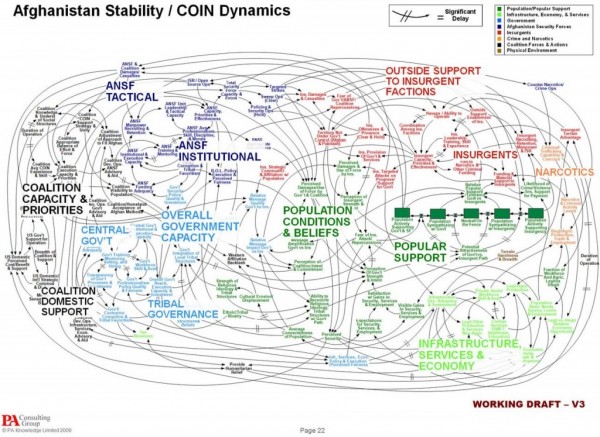


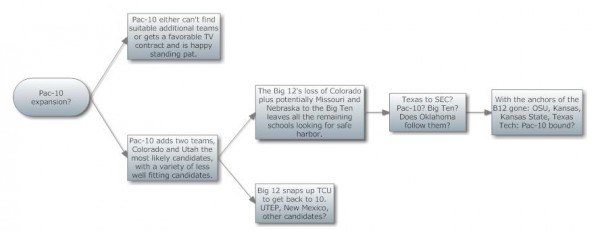
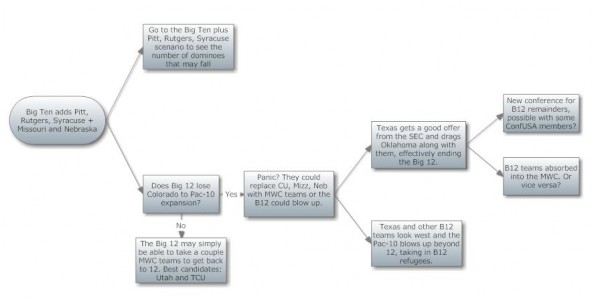
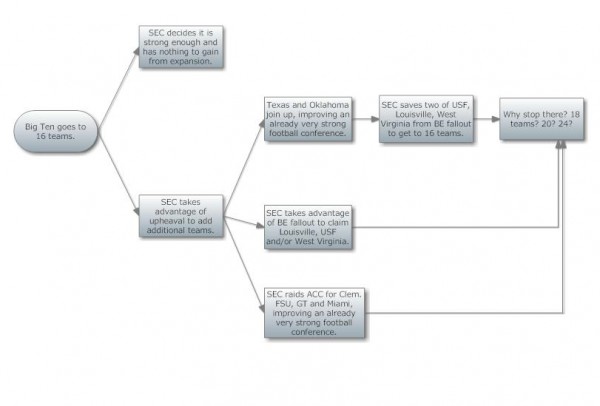
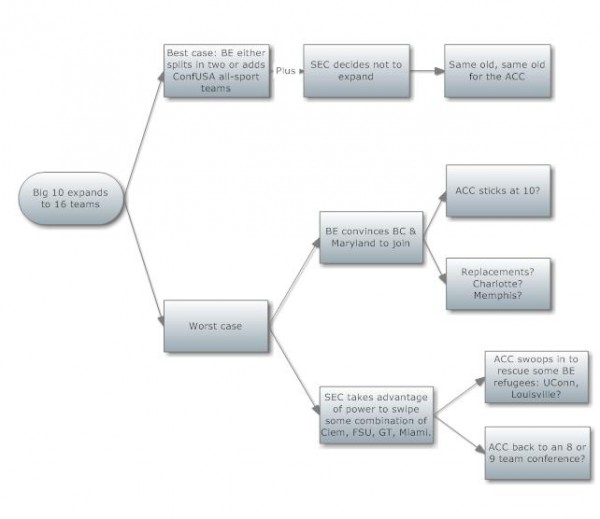














This is great. Better that what I’ve seen on more football-centric blogs. Good work.
I do wonder, though: What would come of some other basketball stalwarts like the MVC or Horizon or WCC? I know they’d probabaly get by largley unscathed, but would they be able to add some teams from all the attrition? For example, if the Big East explodes and the remaining teams raid the A-10 for basketball, that would leave a few teams homeless. I wonder if, under that circumstance, SLU would join the MVC? And if C-USA dissolves, would other guys like Tulsa or Memphis rejoin the MVC (they both used to be members)? I could see that MVC being a force to be reckoned with in hoope. Both Tulsa and Memphis would have nowhere to go for football, but they might be screwed anyway if these super conferences take hold.
Good flow chart fun from @rushthecourt on potential conference realignment: http://bit.ly/cBvpRF
Nebraska to the big 10-Ive lived in Michigan and Ive lived in Nebraska-why? There are more TVs in St. Louis alone and Nebraskas school is no where nere what the big 10 wants and they bring nothing but football. The wont earn their 20 million per year keep.
One angle you don’t explore, and I don’t blame you, because it would all be speculation, is the effect state legislatures and boards of regents will have on this process. The Texas Legislature was very influential last time around, when UT and Texas A&M wanted to go to the Big 8, and legislators forced them to take Texas Tech and Baylor along, too. Expect the same thing to happen this time around if the dominoes start to fall, not only in Texas, but also in Kansas and Oklahoma, too.
Great article and excellent insight.
My only real quibble with your analysis is that you speculate that TCU, UTEP, and New Mexico would be the likely replacements for Colorado’s spot in the Big 12. The problem with TCU and UTEP is that they are in Texas. The Big 12 will surely want to avoid another SWC-like conference, which failed miserably because it was comprised so heavily of one state. Also, I would be shocked if the other TX schools don’t object to another school from their state being brought into the conference. It would dilute the recruiting market and make it much harder to keep their instate recruits. Furthermore, TCU and UTEP really don’t add any new markets to the Big 12 footptint, so its hard to see how these schools would bring in new television revenue, Finally, CU’s spot is in the Big 12 North, and TCU and UTEP are currently in the footpint of the Big 12 South.
New Mexico is an intriuging possibility. It does add a new market and is geographically contiguous with Texas. As with TCU/UTEP, New Mexico appears to be more slated for the Big 12 South, but I guess the conference could be realigned if that is what the Big 12 really wants. My biggest problem with New Mexico is that its football stadium is quite small, and although it enjoys great local support, it is in a small, isolated market. I really think though that BYU or Utah make the most sense to fill any vacancy in the Big 12 North. Both might not work, but either one brings a sizable market, good sports, and a decent amount of fans. BYU probably makes more sense financially because it has a more national following and would therefore add more TV sets and travel a little better than Utah. Plus, if CO leaves the Big 12, it will almost certainly be with Utah. Anyway, just my thoughts; thanks for the great article.
TB – this is a good point. Virginia did the same thing to get the ACC to drag Va Tech into the league a few years ago. That’s where these things could get very messy eventually.
Keith – I’d have trouble calling a conference that lasted 82 yrs (SWC) a miserable failure, but the BYU point is a good one b/c the Pac-10 is almost assured to not take that school into their mix if it expands.
Thanks for the comments.
This is the best expansion article that I have read. Hands-down.
Jack– I tried to do a possible list of basketball conferences after the “BCS” conferences got done with their shuffling and got too confused to get it done properly, but suffice it to say that conferences like the MVC, Horizon and WCC would be jostled around a bit, but given their lack of FBS football schools, would likely remain intact.
Joe– I’d agree that the B10 could find better fits than Nebraska, but I think their priority is upgrading their football programs, since they’ve had plenty of success on the basketball side of late.
TB — That is a whole other ballgame that I have seen plenty of speculation on, which just adds a whole other level of intrigue to the game. The story I remember there is that ex-Texas Gov. Ann Richards, a Baylor alum, was primarily responsible for making sure the Bears were included in the B12.
Keith — I’d agree that UTEP/TCU don’t bring in new markets and that the B12 would much rather have Utah, but the problem is I only see one possible way the Pac-10 expands, and that is if they bring along Colorado and Utah. I don’t see any other schools that are legitimate fits for the Pac-10 in terms of both academics and athletics. So unless the Pac-10 decides not to expand and the B12 is only looking for replacements to whatever schools they may lose to the Big Ten, Utah may not be available for the B12 to take.
And, thanks for the comments everyone.
The NCAA should mandate that conferences be no larger than 12 teams (because if they get any larger than that, they become cumbersome and inefficient in terms of scheduling; the way the Pac-10 schedules is perfect, while the way the Big 12 schedules is at least doable.) and break up any conferences larger than that. It’s not really a conference when 16 teams are in it. The Big East’s big rivalry games only happen once a year in most years.